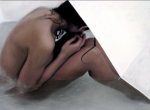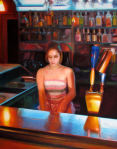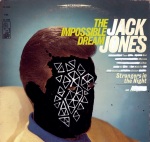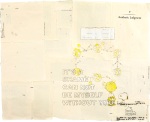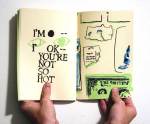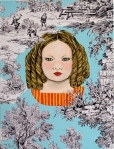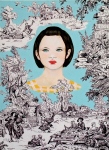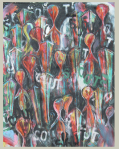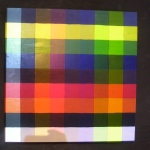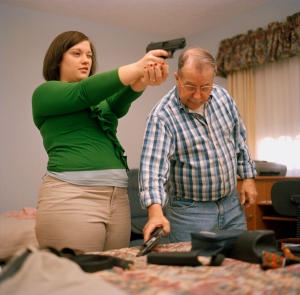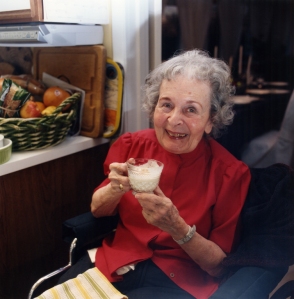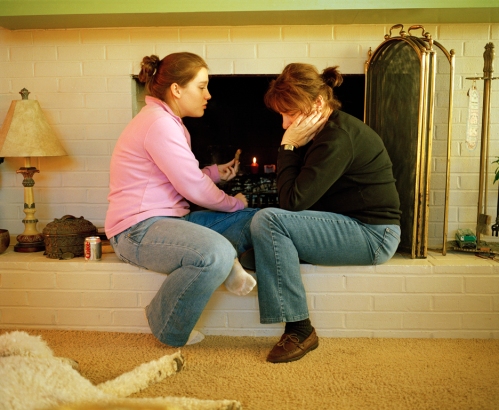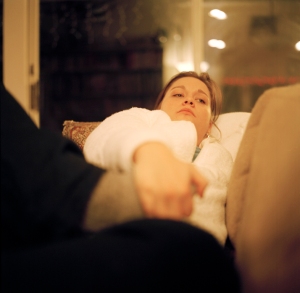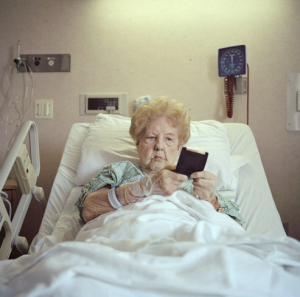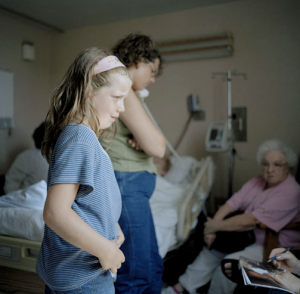Jackie Santos is a painter living in NYC. She was most recently a contestant on Bravo’s reality show, Work Of Art. In this series, 14 artists are competing to receive a solo show at the Brooklyn Museum along with $100,000 check. In each episode, the artists are assigned projects and critiqued at the end by art critic, Jerry Saltz, gallery owners Jeanne Greenberg Rohatyn of Salon 94, Bill Powers of Half Gallery, and host,China Chow.In each episode one or two people get eliminated based on their projects.
I met with Jackie to discuss her new work in her art studio in Long Island City.
LC: I’m looking around your studio and it looks like you’ve been busy! Let’s talk about this new work of yours.
JS: I have always made figurative work – I am currently working on several figurative paintings of women dealing with vulnerability. I’ve always been drawn to the dichotomy of submission verses domination, and I address these themes in many of my paintings. With this series, the imagery is universal and archetypal.
I’m also developing a series of explosion-themed paintings that are made with oil and enamel on canvas.
A year ago, I stopped working for Jeff Koons. I worked as a painting assistant for two years and during that time I was painting really tightly. Afterwards I felt the need to loosen up my painting style, so I began working abstractly for a change of pace. I’ve always been an oil painter, but now I’m also experimenting with enamel and acrylic, and combining photo-realism techniques with expressionistic abstraction. I also wanted to make work that addresses contemporary politics; this is how the explosion series started. I think it’s interesting to attempt to capture the fast gestures of the explosions with meticulous painting… It’s a counter-intuitive act yet it seems to freeze the moment.
LC: Did “Work of Art” fulfill all of your expectations?”
JS: I think I may have had somewhat unrealistic expectations of the show. While my financial situation has improved, I suppose I thought my life would’ve changed much more dramatically. However, I believe true artists absorb everything they experience and are able to utilize what they’ve learned to inspire their artwork. I learned a lot from this experience and it has influenced my work.
I also discovered more about my particular strengths and weaknesses. My three strongest projects on Work of Art were figurative. I always knew one of my strengths was my ability to use the figure to narrate my ideas, but this situation made me appreciate how important it is to follow your strengths – each artist has particular gifts and it’s important to utilize them.
LC: Can you tell me stories with working the figure?
JS: When I evaluate or set up a scenario for an artwork, I tend to hyperbolize whatever it is I find particularly interesting. For example, in the “Audi Challenge” I felt vulnerable because I was in a glass room and there were so many people staring at our situation and at me. This feeling was also magnified because I’d been confined working in seclusion and suddenly for the first time in weeks, I was exposed to the public. My strength in this challenge was to isolate what was important in the situation; by focusing specifically on the men – rather than depicting every onlooker who passed by – I was able to tell a more potent story. The narrative became a male/female power play, rather than a more general depiction of voyeurism. I wanted to shift the power around so that I was in control. I did this by using my camera as a “weapon” to take pictures of THEM, so that THEY became the subject being gazed upon, rather than me.
LC: Were you surprised when you finally saw the show on film and heard some of the commentary from your peers?
JS: I was surprised when I heard Miles take credit for my idea in the “Opposites Attract” challenge. I put a great deal of thought and effort into that piece and I was upset when it was implied that he gave me my idea.
LC: How did you deal with criticism, not only on the show, but from media as well?
JS: I was somewhat prepared from my experience at art school. Although, I think it’s hard for any artist to have their work – and personality – criticized on national television. On the show, they portray me as being rather one-dimensional. In reality, people that know me know I’m much more than that character. But this experience definitely helped me develop a thicker skin.
I was fortunate to receive objective, genuine feedback and encouragement from so many fans. Regarding the criticism, some of it has proved beneficial – anything that wasn’t constructive I just brushed off.
LC: How has it made you stronger?
JS: After experiencing the vulnerability of being videotaped naked on television (among other things) I feel more confident to do anything now. This kind of experience really lets you see who your true friends are; real friends will stand by you through anything, and I was relieved when most of mine did. When the show aired, I felt an incredible amount of anxiety. But now that the show is completed, I feel much more at ease. I am very happy with everything in my life right now.
To read Jackie’s blog and view her work please visit: http://www.jaclynsantos.com

